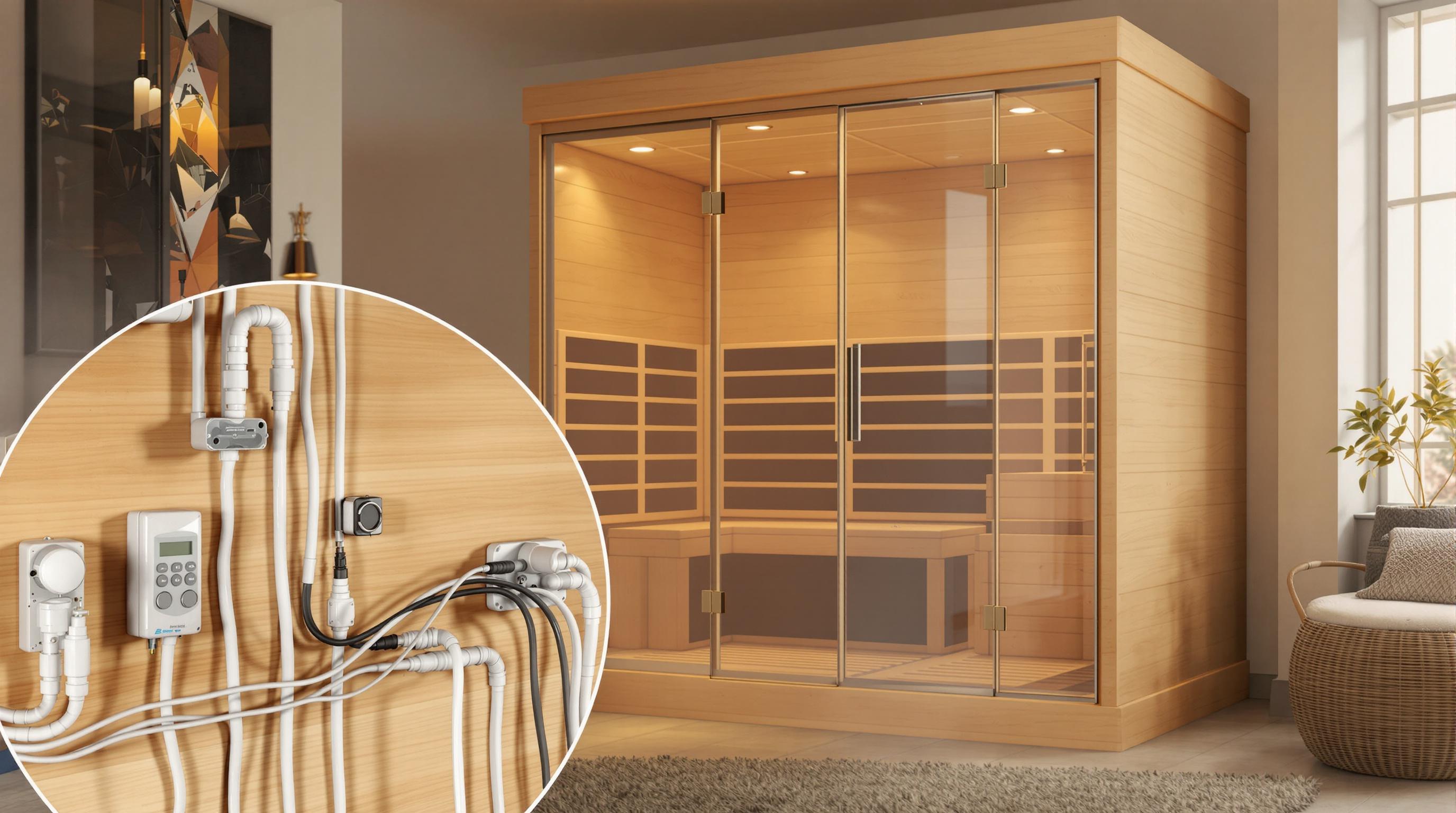Home sauna installation can be tricky but rewarding. Here's what you need to know:
- Types of Saunas: Choose between infrared (easy setup, low energy), traditional (moderate setup, more space), or steam (complex, needs plumbing and drainage).
- Space Requirements: Ensure at least 2 feet of clearance and 7 feet of headroom. A 4-person sauna needs around 8' x 8' space.
- Ventilation & Safety: Proper ventilation prevents CO2 buildup - aim for 1 air exchange per hour. Use heat-resistant wiring and fire-safe materials.
- Permits: Electrical and plumbing work often require permits. Check local codes.
- Professional Help: Complex electrical work or custom designs should be handled by licensed professionals to ensure safety.
Quick Comparison:
| Sauna Type | Space Needed | Installation Difficulty | Key Features |
|---|---|---|---|
| Infrared | Small | Easy | Low energy, precise electrical setup |
| Traditional | Medium | Moderate | Heater clearance, durable frame |
| Steam | Large | Complex | Plumbing, humidity control |
Proper planning, attention to safety, and professional assistance when needed can make your home sauna installation smooth and enjoyable.
Home Sauna Build - Step by Step Guide
1. Getting Ready to Install Your Home Sauna
Proper preparation is key to a smooth sauna installation.
1.1 Picking the Best Spot for Your Sauna
Where you place your sauna matters for both safety and convenience. A flat, sturdy surface like concrete is a must to support its weight, whether you're installing it inside or outside [1]. For indoor setups, opt for a waterproof area with good ventilation and easy access to electricity. Outdoor saunas, on the other hand, need a solid concrete base, weatherproofing, and insulated electrical connections [3].
Choosing the right location makes the installation process much easier.
1.2 Deciding on the Type of Sauna
Each type of sauna comes with its own setup requirements [2]. Infrared saunas are compact, simple to install, and use less energy. Traditional saunas need more space and have a moderate installation process. Steam saunas demand the most room, as well as plumbing and a more complex setup.
Knowing these differences helps you pick the sauna that fits your space and preferences.
1.3 Do You Need Permits for Installation?
In many areas, permits are required for sauna installations, especially if electrical or plumbing work is involved [1]. Check with your local building authority to learn the specific rules in your region. Permits often cover electrical wiring, plumbing, structural adjustments, and ventilation.
Good ventilation is critical for safety and meeting building codes. Taking care of permits upfront avoids potential legal or safety issues later on.
Once you've picked your sauna type and handled the permits, you're ready to tackle the space and setup details.
2. Space and Setup Requirements
2.1 How Much Room Does a Sauna Need?
To set up a sauna safely, leave 2 feet of clearance around the structure and ensure at least 7 feet of headroom for proper ventilation and safety [1]. A typical 4-person sauna needs a room that’s at least 8 feet by 8 feet [1]. The space you’ll need depends on the type of sauna:
| Sauna Type | Space Needs | Key Requirements |
|---|---|---|
| Infrared | Minimal | Requires a dedicated electrical circuit |
| Traditional | Moderate | Needs a heater clearance zone |
| Steam | Largest | Requires space for plumbing and steam equipment |
Once you’ve determined the space, the next step is planning the installation.
2.2 Steps to Install a Sauna
Start by preparing a level, moisture-resistant foundation - concrete works well. Use durable wood like cedar or spruce for the frame. Here’s an overview of the installation process:
- Lay the foundation and moisture barrier.
- Build the insulated frame.
- Add a vapor barrier.
- Set up electrical components.
- Finish by assembling walls and completing the interior.
After the structure is built, proper ventilation is critical for safety and performance.
2.3 Why Ventilation Matters
Good ventilation ensures a safe and comfortable sauna experience. Aim for one complete air exchange per hour [3]. Without proper ventilation, CO2 levels can rise dangerously high, leading to health risks [4].
Key ventilation features include:
- Fresh air intake near the floor and heater.
- Exhaust outlets near the ceiling.
- Basement saunas may require mechanical ventilation [3].
"High levels of CO2 in saunas can cause fatigue and are dangerous in both the long and short term. Proper ventilation helps maintain safe CO2 levels and prevents stratification, where the head is hot and the feet are cold." [4]
Keep in mind that ventilation needs differ based on location. Basement saunas often need mechanical systems, while above-ground setups may rely on natural airflow [4].
3. Safety Tips and When to Call a Professional
3.1 Electrical and Fire Safety Basics
Using heat-resistant wiring and fire-resistant materials is key to maintaining safety. Installing a Ground Fault Circuit Interrupter (GFCI) helps protect against electrical shocks [1].
To reduce fire hazards, pay attention to these essential elements:
| Safety Component | Requirement | Purpose |
|---|---|---|
| Wiring | Heat-resistant cables | Prevents wire damage and degradation |
| Materials & Installation | Fire-resistant walls and ceilings; proper heater mounting | Enhances heat safety and reduces fire risks |
| Ventilation System | One air exchange per hour | Prevents overheating and improves air circulation |
Regularly inspect electrical components - monthly checks can help identify potential issues early. Additionally, keep flammable items far from the sauna area [3].
While these precautions are important, certain aspects of sauna installation may demand professional expertise to ensure everything is set up correctly and safely.
3.2 When to Get Professional Help
For tasks like complex electrical work, custom designs, or meeting strict building codes, it's best to hire a professional. A licensed electrician should handle the electrical setup, especially for the sauna heater [6].
Here’s when you should consider bringing in an expert:
- Complex Electrical Work: If your sauna needs a new circuit or panel upgrades.
- Custom Designs: For installations with unique dimensions or special features.
- Building Code Compliance: When local regulations for sauna setups are particularly strict.
Choose someone experienced with sauna installations and knowledgeable about local codes. A skilled professional will offer a detailed estimate and explain how they’ll ensure proper ventilation and electrical safety [1].
Attempting advanced electrical work without the right expertise can lead to serious risks and expensive repairs. Investing in professional installation ensures everything is done right, keeps you safe, and provides peace of mind [6].
sbb-itb-3953eb0
4. Common Installation Mistakes to Avoid
4.1 Problems with the Foundation or Framing
A solid foundation is critical for your sauna's durability and safety. Skipping steps like leveling the surface or ensuring moisture protection can lead to major issues down the road. Here's what you need to know:
| Foundation Element | Requirement | Why It Matters |
|---|---|---|
| Base Material | Concrete or moisture-resistant materials | Protects against water damage and keeps the structure stable |
| Surface Level | Completely flat within 1/8 inch | Prevents structural problems and ensures even weight distribution |
| Drainage | Proper slope away from the sauna | Keeps moisture from pooling and causing damage |
| Support | Reinforced corners and edges | Helps evenly distribute the sauna's weight |
4.2 Poor Ventilation Setup
Ventilation is key to a sauna that works well and stays safe. Missteps in this area can lead to uneven heating or poor air quality [4]. Here’s a quick breakdown of common issues and how to address them:
| Ventilation Issue | Impact | Solution |
|---|---|---|
| Incorrect Vent Placement | Uneven heat distribution | Place the intake vent near the floor and the exhaust vent near the ceiling |
| Insufficient Air Changes | Build-up of CO2 levels | Ensure the system allows for at least 6 air changes per hour |
| Missing Mechanical Ventilation | Poor air quality, especially in basements | Add an exhaust system to improve airflow |
For saunas in basements, mechanical ventilation isn’t optional - it’s essential to avoid mold and keep air circulating properly [3].
4.3 Electrical Wiring Errors
Mistakes with wiring aren't just costly - they can be hazardous. Common problems like overloaded circuits or loose connections are often avoidable [5]. Here's what to keep in mind:
| Electrical Component | Common Error | How to Avoid It |
|---|---|---|
| Circuit Load | Overloading existing circuits | Use a dedicated circuit specifically for the sauna |
| Wiring Connections | Loose or improper connections | Hire a professional and schedule regular inspections |
| Heater Installation | Incorrect mounting or wiring | Follow the manufacturer’s instructions to the letter |
Electrical work should always be done by licensed professionals to ensure safety and compliance with local codes [5].
5. Extra Tips for a Smooth Sauna Installation
5.1 Choosing the Right Sauna Size
Picking the right sauna size is crucial to ensure it fits your space and meets your needs. Here's a quick guide to common sauna sizes:
| Sauna Size | Dimensions | Capacity | Ideal For |
|---|---|---|---|
| Compact | 4' x 4' | 1-2 people | Small spaces |
| Medium | 6' x 6' | 3-4 people | Families |
| Large | 8' x 8' | 5-6 people | Spacious homes |
Make sure to leave enough clearance around the sauna for easy access and proper ventilation.
5.2 Comparing Sauna Types
Not all saunas are the same. Each type comes with its own features, making it suitable for different preferences. Here's how they compare:
| Feature | Infrared Sauna | Traditional Sauna | Steam Sauna |
|---|---|---|---|
| Heat Source | Infrared panels | Electric or wood heater | Steam generator |
| Operating Temperature | 120-140°F | 150-185°F | 110-115°F |
| Energy Use | Low | Moderate | Moderate |
| Maintenance | Minimal | Moderate | High |
| Installation | Easy | Moderate | Complex |
| Space Needed | Small | Medium | Larger areas |
This breakdown can help you decide which sauna fits your lifestyle and available space.
5.3 Tips for Maintenance and Efficiency
Keep It Clean:
Wipe down surfaces after each use, allow the sauna to air out, and clean it weekly with a gentle detergent or baking soda for tougher stains [1].
Save on Energy:
Use a timer or thermostat to better manage energy usage [2]. Heating during off-peak hours can also help reduce costs.
Inspect Regularly:
Check these areas monthly to keep your sauna in top shape:
- Heater connections and elements
- Door seals and hinges
- Wood surfaces for wear or damage
Taking care of these details ensures your sauna stays functional and enjoyable for years.
Conclusion: Final Thoughts on Home Sauna Installation
Setting up a home sauna takes thoughtful planning and attention to detail to ensure it’s both safe and functional. The key to success lies in preparation and understanding the critical elements involved.
Safety Comes First
Proper ventilation is crucial to avoid unsafe CO2 buildup, which can double without adequate airflow. Make sure your sauna allows at least one complete air exchange per hour through well-placed intake and exhaust vents [3]. This focus on ventilation and safety forms the backbone of a reliable sauna setup.
Get Professional Help When Needed
Electrical work, especially heater installation, should always be done by a licensed professional. Each sauna type - whether infrared, traditional, or steam - comes with its own set of installation needs, which may require specific expertise [2].
| Installation Aspect | Difficulty Level | Professional Help |
|---|---|---|
| Location Planning | DIY-Friendly | Optional |
| Foundation Work | Moderate Difficulty | Recommended |
| Electrical Setup | Professional Only | Required |
| Ventilation System | Moderate Difficulty | Recommended |
| Final Safety Check | Professional Only | Required |
Bringing in professionals not only ensures safety compliance but also enhances your overall sauna experience.
Building for the Long Run
Careful preparation and attention to detail during installation lead to a durable and efficient sauna. A solid foundation, quality materials, and proper electrical work are essential for smooth operation [1][6]. Whether you prefer an infrared, traditional, or steam sauna, understanding the specific installation needs is key [2]. Always stick to safety guidelines and building codes to create a relaxing and secure home retreat.
FAQs
Do you need special wiring for a sauna?
Yes, installing a sauna requires specific electrical wiring designed to meet safety standards. The wiring must be:
- Heat-resistant: Able to handle the high temperatures typical of saunas.
- Moisture-resistant: Built to withstand humid conditions.
- Protected: Installed within a conduit to prevent damage.
A licensed electrician is required for this type of installation to ensure safety and compliance with electrical codes. Key components of the setup include:
| Electrical Component | Requirements | Purpose |
|---|---|---|
| Circuit | Dedicated circuit | Ensures consistent power supply |
| Safety Features | GFCI protection | Reduces the risk of electrical hazards |
| Installation Method | Conduit system | Protects wiring from moisture and damage |
Given the high heat and humidity in saunas, proper electrical installation is essential to prevent system failures or hazards [6].
"Electrical wiring for a sauna must be installed by a licensed electrician and rated for high temperature and moisture."
While wiring is a critical aspect of sauna safety, don’t forget to also focus on proper ventilation and a solid foundation for a fully functional setup.


